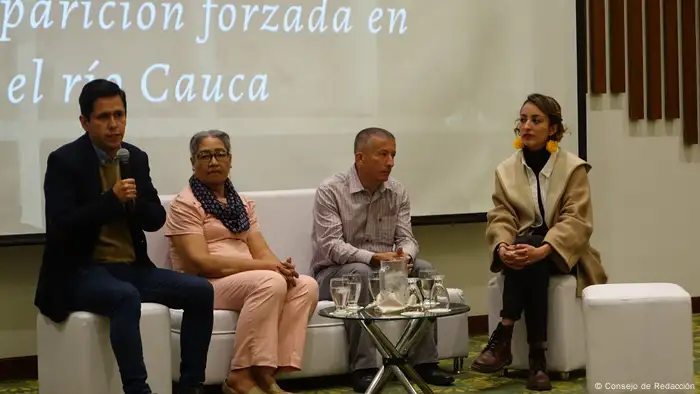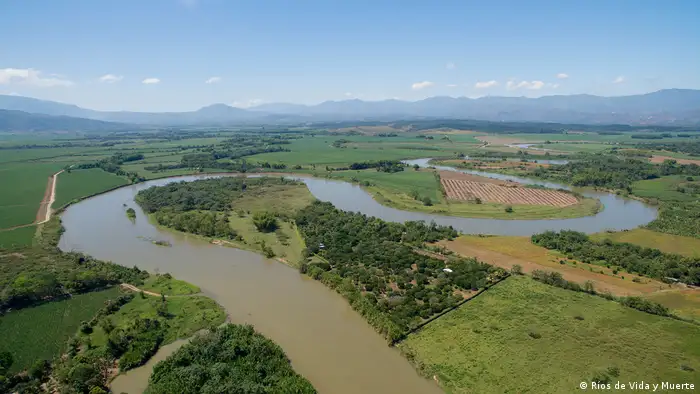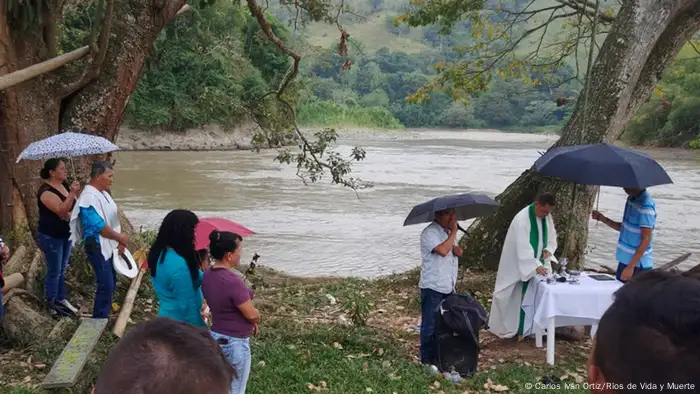Latin America
Ríos de Vida y Muerte: Journalism that brings justice to victims of enforced disappearance
Recent findings by Consejo de Redacción and Rutas del Conflicto on forced disappearance, with the support of DW Akademie, contribute to a landmark decision by a Colombian justice agency.
Warning: This article contains graphic descriptions of violence, which may offend some readers.
With almost two decades of experience covering human rights aggressions, Oscar Parra believes in a journalism which aims not necessarily to reach the masses, but rather to achieve justice. That mission has been accomplished with the declaration of the Cauca River as a victim of Colombia's armed conflict.
For months, about 15 journalists traveled the Cauca River collecting information and testimonies from victims of forced disappearance. Their reporting project is is a collaborative effort, the Ríos de Vida y Muerte project, carried out by Consejo de Redacción in alliance with Rutas del Conflicto and with DW Akademie's support, as well as the media organizations Hacemos Memoria and Vokaribe Radio. The data collected confirm that hundreds of people were thrown into the river by armed groups in at least 22 municipalities.
This information evolved into a database that the team handed over to the Comisión de la Verdad [Truth Commission], the Unidad Especial de Búsqueda de Personas Desaparecidas de Colombia [the Colombian Special Unit for the Search for Disappeared Persons] and the Jurisdicción Especial para la Paz (JEP) [Special Jurisdiction for Peace (JEP)].
On July 11, 2023, the JEP accredited the Cauca River as a victim of the armed conflict, following a petition by Afro-Colombian community councils in the northern department of Cauca, who denounced use of the river as a mass grave for victims of the conflict between 2000 and 2004, as well as a dumping ground for chemicals derived from illegal mining, as well as the production of illicit substances by armed groups.
This statement, which acknowledges the damage caused and gives local communities greater powers to protect the nature around them, explicitly mentions the influence of the videos and testimonies of the Ríos de Vida y Muerte project in the decision (the statement can be downloaded below).
Parra, director of Rutas del Conflicto, gives us an insight into the investigative process, and how it marks a historic milestone in seeking justice for the victims of forced disappearance in Colombia.

Óscar Parra presents the project in 2019 with Temilda Vanegas, victim of the conflict; Albeiro Cañas, Fire Brigade commander; and Lia Valero, journalist of Rutas del Conflicto
DW Akademie: The Ríos de Vida y Muerte project has achieved an exceptional result for its journalistic work. What characteristics make it so exceptional?
Óscar Parra: We have worked on a form of experimental journalism based on the voices of the victims of forced disappearance and in using databases to tell those stories.
It all started about nine years ago, when we made contact with some victims of enforced disappearance and felt that there were many people looking for their missing relatives. There were strong indications that they had been thrown into Colombian rivers. Then, over time, we began to realize the dimension of the crime of enforced disappearance: in Colombia it is estimated that there are between 90,000 and 100,000 people missing. It was then that we decided to start building maps with the voices of those searching for victims in the rivers and to collect material that would be useful for the country's judicial or administrative authorities.
We teamed up with forensic professionals to look for mass graves along the rivers. Sometimes the bodies would come down the river and people had no way to get them to the town cemetery, so they would pull them out and bury them in a mass grave right there; or sometimes the river would push the bodies to the side and those places would become constant points of body sightings.
We collected information from about 50 rivers in the country and did more detailed work on some of the rivers where more cases of disappearance had been reported. One of those rivers is the Cauca River, the second longest river in the country. The Special Jurisdiction for Peace, a justice commission that was born out of the peace agreement with the FARC [Revolutionary Armed Forces of Colombia] and has a restorative justice approach, has used the information we published to support the decision to declare the Cauca River a victim of the armed conflict.
What are the biggest challenges in covering enforced disappearances in Colombia?
The safety of the sources and their mental health. Many people who are looking for their relatives who have been missing for 20 or 30 years continue to receive death threats and, in addition, corpses continue to appear in several rivers. On the other hand, there are many cases that are surrounded by terrible violence. For example, in the Magdalena River, several people had been dismembered and one of the sources was looking in a pile of remains for some trace of a relative. There are also people who, although they had no relatives who were victims, have dedicated their lives to rescuing fragments of bodies from the river to give them a dignified burial. These are very painful situations and we try not to re-victimize these people.
In addition, it is key to understanding the effects that listening to so much pain has on journalists who do such investigative reporting.
What lessons can be learned from this collaborative project?
The importance of the partnership with Consejo de Redacción and DW Akademie. DW Akademie understood the proposal, the relevance and the key of the information gathering. In addition to financial support, they offered us a training process to improve storytelling, interaction with sources and distribution of tasks, for example.
It is essential to have this type of report outline. If we are going to talk about 50 rivers, we need journalists who know the river environments, who work in those regions. Without this type of collaborative journalism, it would have been impossible. In addition, we included professionals from other areas that did not necessarily have to do with journalism, such as forensic specialists, developers and designers to build the maps.
To carry out these multidisciplinary and collaborative journalism exercises, we need more spaces in which civil society organizations and professionals from journalism and academia, among others, come together. Unfortunately, we still continue to live as isolated individuals, but these types of projects are an example of the value of teamwork.
What changes do you expect to improve investigative coverage of human rights issues?
In the future, we hope to continue having meeting points with other organizations to continue telling these stories and contributing to the victims of the country. There are still many families searching for their missing relatives, who do not have the certainty of a body to mourn and close the mourning. The agony of this lack of information is tremendously painful.
In Colombia, it is very difficult to engage the audience with issues related to the armed conflict or human rights. That is why journalism that provides key information for the entities in charge of investigating and for the victims, that helps people who are looking for their relatives, is presented as a great alternative in the construction of journalistic information. As a journalist, to have our information used in decisions like this is better than any award. Nothing recognizes journalistic work as much as having it used to bring justice.
This initiative was conducted between 2015 and 2019 by Consejo de Redacción in alliance with Rutas del Conflicto, with the support of DW Akademie, and its allies in Colombia Hacemos Memoria and Vokaribe Radio, as well as the Pontificia Universidad Javeriana. It was supported by Germany's Federal Ministry for Economic Cooperation and Development (BMZ).
WWW links
Downloads
- Date 04.10.2023
- Feedback: Send us your feedback.
- Print Print this page
- Permalink https://p.dw.com/p/4WsTN
- Date 04.10.2023
- Send us your feedback.
- Print Print this page
- Permalink https://p.dw.com/p/4WsTN


